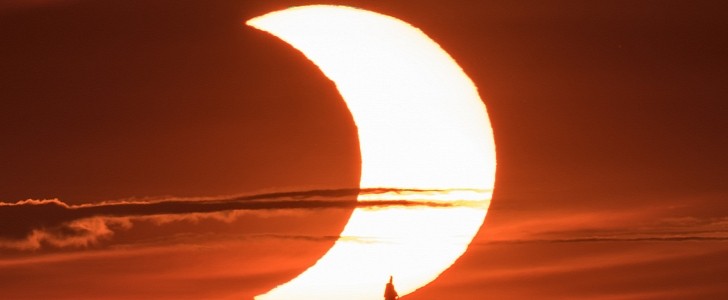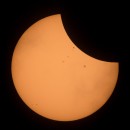April 30th is a special date for skywatchers. A stunning celestial phenomenon takes place on Saturday night: a rare Black Moon will partially block the Sun, causing the first solar eclipse of 2022.
Solar eclipses occur when the Moon blocks some (or all) of the Sun's light, casting a massive shadow on our planet. The event that we're witnessing tonight happens when the Moon and the star are not perfectly aligned, so the satellite doesn't totally cover it.
From our perspective, the Sun will look as if the Moon took a bite out of it, and not just any Moon, but a Black Moon. While this is not an astronomical term, it commonly refers to a second new Moon in a calendar month. According to the Almanac, it's a rare phenomenon that takes place about every 32 months. The first new Moon of April was on April 1st. The second one – you guessed it – is today.
Those with clear skies from Chile, Argentina, Uruguay, western Paraguay, southern Bolivia, southeastern Peru, and southwestern Brazil will see the Sun partially hidden as it sets. The eclipse will also be visible throughout regions in Antarctica, parts of southern South America, the Atlantic Ocean, and the Pacific and Southern Oceans.
The eclipse starts at 2:45 p.m. ET, and the deepest part will be at 4:41 p.m. ET. Skywatchers will see the Sun partially blocked until 6:37 p.m. ET. If you're planning to enjoy this unique celestial show, do not watch the Sun without a proper solar filter, even if it's somewhat obscured.
NASA recommends wearing special solar viewing or eclipse glasses throughout the entire eclipse. If you don't own a pair, you can still watch the spectacle with the help of a pinhole projector, which projects sunlight onto a surface. There's a video attached below that shows you how to DIY one from a cereal box. It will come in handy for the next partial solar eclipse as well, which is set to take place on October 25th.
From our perspective, the Sun will look as if the Moon took a bite out of it, and not just any Moon, but a Black Moon. While this is not an astronomical term, it commonly refers to a second new Moon in a calendar month. According to the Almanac, it's a rare phenomenon that takes place about every 32 months. The first new Moon of April was on April 1st. The second one – you guessed it – is today.
Those with clear skies from Chile, Argentina, Uruguay, western Paraguay, southern Bolivia, southeastern Peru, and southwestern Brazil will see the Sun partially hidden as it sets. The eclipse will also be visible throughout regions in Antarctica, parts of southern South America, the Atlantic Ocean, and the Pacific and Southern Oceans.
The eclipse starts at 2:45 p.m. ET, and the deepest part will be at 4:41 p.m. ET. Skywatchers will see the Sun partially blocked until 6:37 p.m. ET. If you're planning to enjoy this unique celestial show, do not watch the Sun without a proper solar filter, even if it's somewhat obscured.
NASA recommends wearing special solar viewing or eclipse glasses throughout the entire eclipse. If you don't own a pair, you can still watch the spectacle with the help of a pinhole projector, which projects sunlight onto a surface. There's a video attached below that shows you how to DIY one from a cereal box. It will come in handy for the next partial solar eclipse as well, which is set to take place on October 25th.







